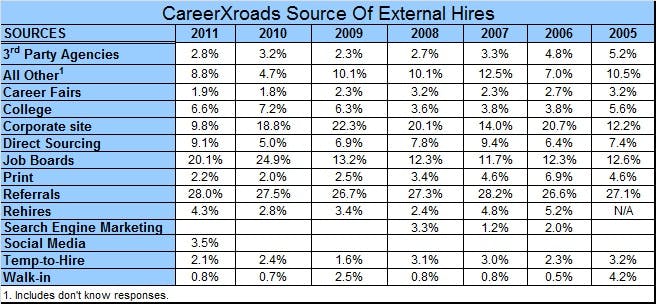America’s largest companies are still turning to third party agencies for help with their difficult to fill jobs at about the same rate they have for the last few years.
A recent source of hire survey by the CareerXroads consultancy found 2.8% of all external hires last year came from third party recruiters. That’s down from 2010, but it’s still a marked improvement from the worst of the recession.
Indeed, third party agency use ebbs and flows with economic conditions, as the accompanying chart of large employer data shows. Over the long term, however, the downward trend in the use of contingent recruiters is clearly evident.
In 1997, the Employment Management Association found that 10.4% of hires were attributed to contingent recruitment firms. Search firms sourced another 2.1%. Three years later, the association found 6.8% of hires coming from agencies and 1.6% from executive search.
What changed? Part of the explanation is that Internet usage exploded during that time. In the 1997 survey only 2.1% of hires were sourced from the Internet. In the 2000 report, the EMA found 27.4% of hiring was being done online.
Despite that meteoric rise in online sourcing, it would be wrong to say the Internet is entirely responsible for reductions in the use of third party recruiters. More probably, as many HR leaders have reported, large employers have bolstered their in-house recruiting programs, diminishing the need to go outside.
This in-sourcing hits at exactly the sweet spot for third party recruiters — earners in the upper payscales, but not executive level, and the harder-to-fill critical jobs. As more attention has been focused on talent management, the largest employers — the ones that participate in the CareerXroads annual survey — have put ever more emphasis on developing their own pipelines to ensure a steady stream of candidates-in-waiting.
Certainly, the thesis is reasonable, however, the data on source of hire nationally, over time, just isn’t strong enough to draw firm conclusions. For instance, the EMA surveys polled a far different group of employers than did CareerXroads. For data purists then, it’s not quite as bad as apples to pineapples, but more like comparing different types of apples.
Still, the CareerXroads data alone shows a general decline in third party hires among the survey participants. Furthermore, 54.3% of the employers said all of their full time hiring is done with in-house recruiters.
What this suggests is that to grow a business, agency owners aren’t looking to the biggest companies, but at those more in the mid-range. Employers with a modest recruiting staff, or with generalists filling multiple roles, are the most likely to need the help of outside recruiting professionals when critical openings arise.
The Association of Executive Search Consultants 2011 recruitment survey found companies most likely to turn to contingent recruiters to fill jobs in the $100k-$200k range. “Overall respondents saw strengths in contingency recruiting,” the survey notes, “when timelines were limited and cost was an issue.”
What kind of company does that describe, if not mid-sized firms and smaller companies with specialty jobs?
